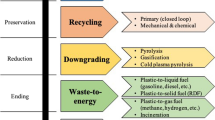Abstract
This paper presents the results of a study of the use of scrap tire material as a sorbent medium for sorption of volatile organic chemicals from organic mixtures and water. The tire material was exposed to pure solvents to establish the sorption characteristics for classes of organics. The overall rate and selectivity of sorption of a solvent in a polymeric material is determined by its diffusivity and solubility in the polymeric material. Literature studies show that polymer-solvent interactions could arise due to electron acceptor-donor charge transfer complexes occurring between the functional groups in rubber and solvent functional groups. This was postulated to be a major contributor toward selective sorption of solvents in tire.
The technical feasibility of separating organic solvents from both organic and aqueous mixtures by exploiting the diffusional and solubility related characteristics of various solvents in tire, which is a crosslinked rubber, has been established. Three types of separations were studied: (1) a mixture of two alkanes of significantly different sizes, represented by n-octane, a light alkane, from 2,6,10,14-tetramethylpentadecane, a branched C19 heavy alkane; (2) a mixture of two organic solvents used in extraction and differing in polarity, represented by chloroform and methanol, that form a minimum boiling azeotrope; and (3) removal of an organic form water, represented by TCE contaminated water.
Organic molecules having similar polarity could be separated based on substantial size differences, whereas polar/nonpolar organics separation could be achieved based on solubility differences of the organics in the tire phase. The feasibility of using tire material for the separation of trichloroethylene (TCE) from contaminated water was also established. The equilibrium partitioning of the TCE was linearly proportional to its concentration in the aqueous phase in the range of 25 to 600 mg/l. Desorption studies were performed to establish the ease of regeneration of the sorbent material, restoring its sorption capacity and recovering the solvent. The studies indicated that more than 97% of sorbed solvent (TCE) can be recovered at 25 °C under a vacuum of 20 Torr for under 10 minutes.
Similar content being viewed by others
Author information
Authors and Affiliations
Additional information
Received: 4 December 1998 / Accepted: 10 February 1999
Rights and permissions
About this article
Cite this article
Rangarajan, P., Sisk, P. & Bhattacharyya, D. Novel applications of scrap tire for organic sorption/separations. Clean Products and Processes 1, 199–209 (1999). https://doi.org/10.1007/s100980050028
Issue Date:
DOI: https://doi.org/10.1007/s100980050028
- AbbreviationsBranched C19: 2,6,10,14 Tetramethylpentadecane
- DBE: 1,2 Dibromoethane
- DCE: Cis-1,2 dichloroethylene
- DNAPL: Dense phase aqueous phase liquid
- LNAPL: Light phase aqueous phase liquid
- Octane: n-Octane
- PCE: 1,1,2,2 Tetrachloroethylene
- SBR: Styrene butadiene rubber
- crosslinked SBR: SBR from Utex industries, TX
- TCE: 1,1,2 Trichloroethylene




